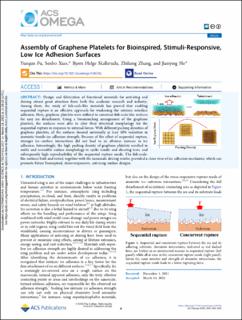| dc.contributor.author | Fu, Yuequn | |
| dc.contributor.author | Xiao, Senbo | |
| dc.contributor.author | Skallerud, Bjørn Helge | |
| dc.contributor.author | Zhang, Zhiliang | |
| dc.contributor.author | He, Jianying | |
| dc.date.accessioned | 2022-10-24T10:43:21Z | |
| dc.date.available | 2022-10-24T10:43:21Z | |
| dc.date.created | 2022-03-16T11:24:32Z | |
| dc.date.issued | 2022 | |
| dc.identifier.issn | 2470-1343 | |
| dc.identifier.uri | https://hdl.handle.net/11250/3027846 | |
| dc.description.abstract | Design and fabrication of functional materials for anti-icing and de-icing attract great attention from both academic research and industry. Among them, the study of fish-scale-like material has been proved that enabling sequential rupture is an effective approach for weakening the intrinsic interface adhesion. Here, graphene platelets were utilized to construct fish-scale-like surfaces for easy ice detachment. Using a biomimicking arrangement of the graphene platelets, the surfaces were able to alter their structural morphology for sequential rupture in response to external forces. With different packing densities of graphene platelets, all the surfaces showed universally at least 50% of reduction in atomistic tensile ice adhesion strength. Because of the effect of sequential rupture, stronger ice-surface interactions did not lead to an obvious increase in ice adhesion. Interestingly, the high packing density of graphene platelets resulted in stable and reversible surface morphology in cyclic tensile and shearing tests, and subsequently high reproducibility of sequential rupture mode. The fish-scale-like surfaces built and tested, together with the nanoscale de-icing results, provided a close view of ice adhesion mechanics, which can promote future bio-inspired stress-responsive anti-icing surface designs. | en_US |
| dc.language.iso | eng | en_US |
| dc.publisher | American Chemical Society | en_US |
| dc.rights | Navngivelse 4.0 Internasjonal | * |
| dc.rights.uri | http://creativecommons.org/licenses/by/4.0/deed.no | * |
| dc.title | Assembly graphene platelets for bioinspired, stimuli-responsive, low ice adhesion surfaces | en_US |
| dc.type | Peer reviewed | en_US |
| dc.type | Journal article | en_US |
| dc.description.version | publishedVersion | en_US |
| dc.source.journal | ACS Omega | en_US |
| dc.identifier.doi | 10.1021/acsomega.1c06782 | |
| dc.identifier.cristin | 2010175 | |
| dc.relation.project | Notur/NorStore: nn9391k | en_US |
| dc.relation.project | Notur/NorStore: nn9110k | en_US |
| dc.relation.project | Norges forskningsråd: 255507 | en_US |
| dc.relation.project | Norges forskningsråd: 250990 | en_US |
| cristin.ispublished | true | |
| cristin.fulltext | preprint | |
| cristin.fulltext | original | |
| cristin.qualitycode | 1 | |

